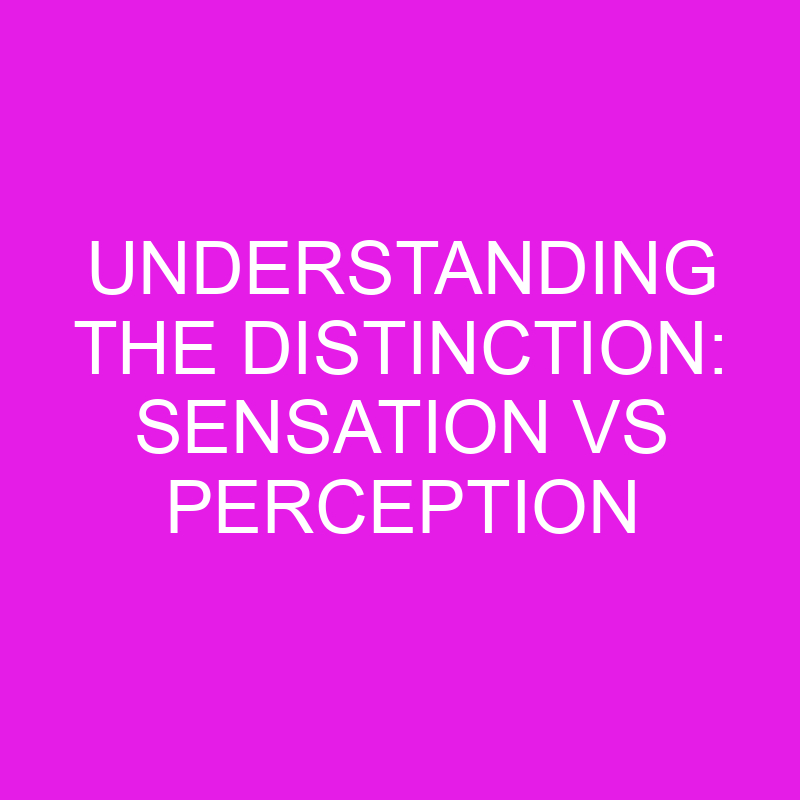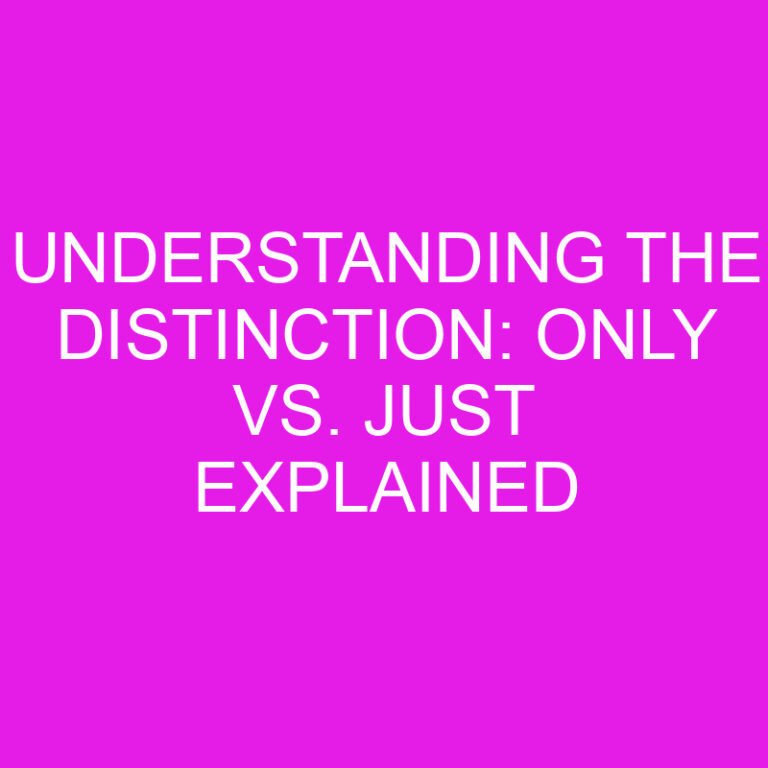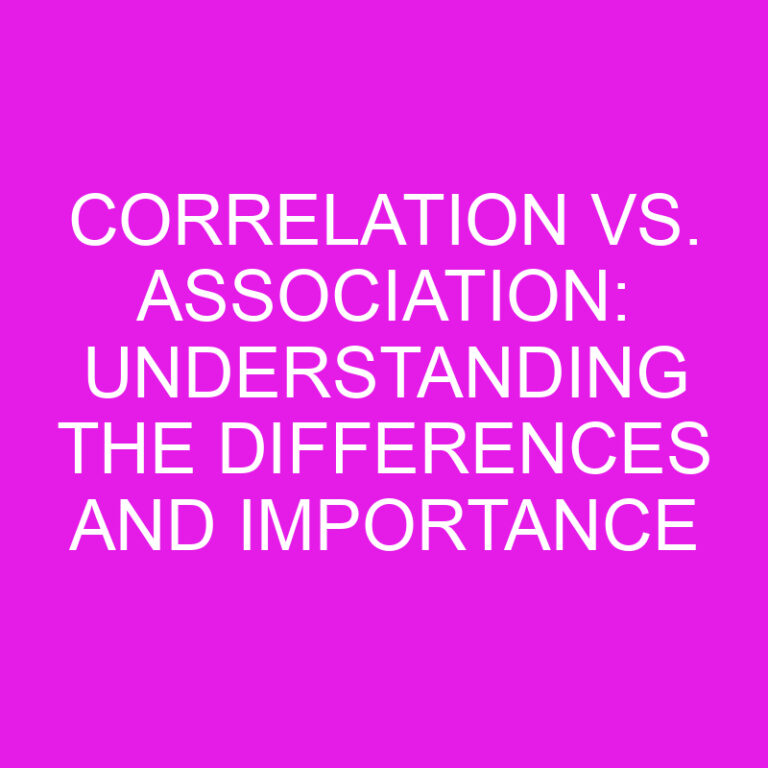
Have you ever wondered how we experience the world around us? How do we make sense of the multitude of stimuli bombarding our senses every second? The answers lie in the fascinating realms of sensation and perception. In this article, I’ll delve into the intricacies of these two concepts and shed light on the key differences between them.
Sensation, in simple terms, refers to the process of detecting and receiving information from our environment through our senses. It is the raw data that our sensory organs, such as our eyes, ears, nose, tongue, and skin, gather and transmit to our brain. Think of it as the initial step in the journey of perception, where the stimuli are registered and transmitted to our brain for further processing.
Perception, on the other hand, goes beyond mere detection. It involves the interpretation and organization of the sensory information received by our brain. Perception allows us to make sense of the world by giving meaning and significance to the sensations we experience. It involves complex cognitive processes that help us recognize objects, understand their properties, and form meaningful perceptions of our surroundings.
So, join me as we explore the fascinating world of sensation and perception, and uncover the nuances that make them distinct yet intertwined aspects of our everyday experiences.
Post Contents
- Key Takeaways
- Sensation: Detecting and receiving information from the environment
- Perception: Interpreting and organizing sensory information
- Understanding Sensation: The raw data gathered by our sensory organs
- Understanding Perception: Giving meaning and significance to sensations
- The Relationship between Sensation and Perception: Distinct yet intertwined aspects
- Conclusion: The fascinating world of sensation and perception
- Frequently Asked Questions
Key Takeaways
- Sensation refers to the process of detecting and receiving information from our environment through our senses, while perception involves the interpretation and organization of sensory information.
- Sensation is the initial step in the process of sensory processing, where sensory organs detect and receive information from the environment.
- Perception is the subsequent stage where sensory information is interpreted and given meaning, taking into account past experiences, knowledge, and expectations.
- Sensation and perception work together to create a cohesive and integrated understanding of the world around us.
- Factors such as cultural, social, and individual differences can influence perception.
- Top-down processing and bottom-up processing are two important mechanisms involved in perception.
Sensation: Detecting and receiving information from the environment
When it comes to understanding how we perceive the world around us, it is important to delve into the concept of sensation. Sensation refers to the initial process of detecting and receiving information from our environment through our senses. It is the entry point for all the incredible sensory experiences that shape our perception.
In simple terms, sensation is the raw data that our sensory organs, such as the eyes, ears, nose, tongue, and skin, pick up from the environment. It involves detecting and encoding information about the various sensory stimuli that surround us. This information is then transmitted to the brain, where the process of perception takes place.
During the process of sensation, our sensory receptors convert the stimuli present in the environment into electrical signals that can be understood by our brain. For example, in the case of vision, light enters our eyes and is focused by the lenses onto the retina. The photoreceptor cells in the retina then convert the incoming light into electrical signals, which are conveyed to the brain via the optic nerve.
Each sense has its own unique set of receptors specialized to detect specific types of stimuli. For instance, the olfactory receptors in our nose are responsible for detecting different scents, while the auditory receptors in our ears allow us to perceive sound waves. The characteristics of each sensory receptor determine the type of information it can detect and transmit to the brain.
Sensation is a continuous process that occurs instantaneously and automatically. We are constantly bombarded with sensory stimuli from our environment, and our senses are constantly at work, translating this information into meaningful data that our brain can process. This constant stream of sensory information forms the foundation for our perception of the world around us.
Understanding the distinction between sensation and perception is crucial. While sensation involves the initial process of gathering sensory information, perception is the subsequent stage where this information is interpreted, organized, and given meaning. Together, sensation and perception work in tandem to provide us with a rich and integrated experience of the world.
By grasping the fundamental role of sensation, we can appreciate how our senses work tirelessly to collect information from the environment and pave the way for meaningful perception.
Perception: Interpreting and organizing sensory information
Perception is the next stage in the process of sensory processing, where the brain takes the electrical signals received from the senses and interprets them, giving meaning to the information. It involves organizing and making sense of all the sensory input we receive from the environment.
During perception, the brain integrates and processes the sensory information received to create a coherent and meaningful understanding of the world around us. It takes into account our past experiences, knowledge, and expectations to form a complete picture.
Perception is influenced by various factors, including cultural, social, and individual differences. These factors shape the way we perceive and interpret sensory information. For example, someone from a different culture or background may interpret the same sensory input differently based on their unique experiences and beliefs.
One important aspect of perception is top-down processing, where our pre-existing knowledge and expectations influence how we perceive and interpret sensory information. This means that our past experiences and beliefs can override the actual sensory input we receive. For example, if you see an object from a distance and it appears blurry, your brain may fill in the missing details based on your knowledge of similar objects, allowing you to perceive it as something familiar.
On the other hand, bottom-up processing is the opposite, where sensory information is processed from the bottom (raw sensory input) up to the brain. This type of processing is more focused on the actual sensory input rather than previous knowledge.
Perception is not always accurate, and optical illusions are a prime example of this. These illusions trick our brains into perceiving something that is not actually there. They reveal the complexities of perception and how easily our brains can be deceived.
Understanding the distinction between sensation and perception is crucial because it allows us to appreciate the complexity of our sensory experience. While sensation is the initial detection of sensory information, perception is the cognitive process that gives that information meaning. Together, sensation and perception help us create a cohesive and integrated understanding of the world around us.
In the next section, we will explore how perception can be influenced by various factors and dive deeper into the fascinating world of sensory processing.
Understanding Sensation: The raw data gathered by our sensory organs
Sensation is the initial step in the process of sensory processing, where our sensory organs detect and receive information from the environment. It is a vital mechanism that allows us to interact with the world around us and gather the essential data needed for further processing.
Our senses, including sight, hearing, taste, smell, and touch, serve as the gateway to our sensory experience. Each sense has its own specialized receptors, which are responsible for detecting specific types of stimuli. For example, our eyes contain light-sensitive cells that enable us to see, while our ears have receptors that detect sound waves.
When sensory stimuli are detected, they are converted into electrical signals that travel to our brain through the nervous system. This conversion allows for the transmission of this data to the brain, which plays a crucial role in the interpretation and understanding of the sensory input.
Sensation is a continuous and automatic process that occurs constantly. We are constantly bombarded with sensory information from the environment, even when we are not consciously aware of it. For instance, we may not always notice the background noise in a crowded room, but our ears are still picking up the sound waves.
It is important to recognize that sensation is distinct from perception. While sensation involves the detection and transmission of sensory information, perception is the subsequent stage where this information is interpreted and given meaning. The understanding of this distinction helps us appreciate the complexity of our sensory experience and how it contributes to creating a cohesive and integrated understanding of the world around us.
Sensation is the raw data gathered by our sensory organs, allowing us to detect and receive information from the environment. It is a continuous and automatic process that occurs constantly, providing us with the necessary input for further processing. By understanding the distinction between sensation and perception, we can gain a deeper appreciation for the intricacies of our sensory experience.
Understanding Perception: Giving meaning and significance to sensations
Perception is the next stage in the process of sensory processing, where the sensory information received during sensation is interpreted and given meaning. It is through perception that we make sense of the world around us and form a coherent understanding of our environment.
During perception, the brain integrates and processes the sensory information received during sensation, taking into account our past experiences, knowledge, and expectations. This process allows us to organize and interpret the raw sensory data, giving it context and meaning.
Perception is a complex and multifaceted process, influenced by various factors such as cultural, social, and individual differences. These differences can shape our perception based on our unique backgrounds, beliefs, and values.
Top-down processing and bottom-up processing are two important mechanisms involved in perception. Top-down processing refers to the influence of our prior knowledge, experiences, and expectations on perception. It allows us to use our existing mental frameworks and concepts to make sense of sensory information. In contrast, bottom-up processing involves the analysis and integration of sensory information from the environment without the influence of preconceived notions or expectations.
Optical illusions provide an interesting example of how perception can be influenced. Optical illusions exploit the way our brain processes visual information, creating discrepancies between what we see and what is actually there. These illusions demonstrate that perception is not always an accurate representation of reality, highlighting the complexities of our perceptual processes.
Understanding the distinction between sensation and perception is crucial as it allows us to appreciate the complexity of our sensory experience and how it helps us create a cohesive and integrated understanding of the world. By unraveling the intricacies of perception, we gain insights into how our brains construct our reality and how our unique perspectives shape our perceptions. So let’s dive deeper into the fascinating world of perception and explore its wonders.
The Relationship between Sensation and Perception: Distinct yet intertwined aspects
Sensation and perception are two interconnected aspects of our sensory experience. While they are distinct processes, they work together to create our understanding of the world around us.
1. Sensation: As discussed earlier, sensation is the initial step in the process of sensory processing. It involves the detection and reception of information from our environment through our sensory organs. Each sense has its own specialized receptors that detect specific types of stimuli, such as light, sound, taste, touch, and smell.
2. Perception: Perception is the subsequent stage where sensory information is interpreted and given meaning. During perception, the brain integrates and processes the sensory information received during sensation. It takes into account our past experiences, knowledge, and expectations to create a coherent understanding of our environment.
3. Interplay between Sensation and Perception: Sensation provides the raw sensory data, while perception organizes and interprets this data to give it context and meaning. They rely on each other to create a cohesive and integrated understanding of the world.
4. Influence of Factors on Perception: Various factors, including cultural, social, and individual differences, can significantly influence perception. Our unique backgrounds, beliefs, and values shape how we perceive the world around us. Additionally, top-down and bottom-up processing mechanisms also play a role in perception.
5. Top-Down Processing: Top-down processing refers to the influence of our prior knowledge, experiences, and expectations on perception. It allows us to use our existing mental frameworks and concepts to make sense of sensory information. It shapes how we interpret and assign meaning to the sensory data received during sensation.
6. Bottom-Up Processing: In contrast, bottom-up processing involves the analysis and integration of sensory information from the environment without the influence of preconceived notions or expectations. It focuses solely on the sensory input and does not rely on prior knowledge or experiences.
Understanding the relationship between sensation and perception is crucial in appreciating the complexity of our sensory experience. While sensation provides the foundation, perception gives us the ability to make sense of our environment. This interplay is what allows us to form a coherent understanding of the world and navigate through it effectively.
Conclusion: The fascinating world of sensation and perception
Exploring the intricate relationship between sensation and perception has been a fascinating journey. We have discovered that while sensation is the initial step in sensory processing, perception is where the magic happens. Our sensory organs detect and receive information from the environment during sensation, but it is during perception that this information is interpreted and given meaning.
The brain plays a crucial role in this process, integrating and processing the sensory information received during sensation to create a coherent understanding of our environment. It is amazing to think about how our brains can take in a multitude of sensory inputs and seamlessly weave them together into a meaningful experience.
We have also learned that perception is not a one-size-fits-all process. Cultural, social, and individual differences can influence how we perceive the world around us. Additionally, the mechanisms of top-down and bottom-up processing play important roles in shaping our perceptions, with prior knowledge and expectations influencing our interpretation of sensory input.
Understanding the complex interplay between sensation and perception gives us a deeper appreciation for the richness and diversity of our sensory experiences. It reminds us that our perception of the world is not just a passive reflection of reality, but an active and dynamic process shaped by our individual perspectives.
As we conclude this exploration, I hope that you have gained a greater understanding of the fascinating world of sensation and perception. It is a reminder of the incredible capabilities of our brains and the wonder that lies in our everyday sensory experiences.
Frequently Asked Questions
Q: What is sensation?
Sensation is the initial step in sensory processing, where our sensory organs detect and receive information from the environment.
Q: What is perception?
Perception is the subsequent stage where sensory information is interpreted and given meaning.
Sensation and perception are distinct yet interconnected. Sensation provides the raw sensory input, while perception involves the brain’s processing and interpretation of that input.
Q: What factors can influence perception?
Various factors, including cultural, social, and individual differences, can influence perception.
Q: What are the mechanisms involved in perception?
Top-down processing, which involves the influence of prior knowledge and expectations, and bottom-up processing, which focuses solely on sensory input, are important mechanisms in perception.
Q: Why is understanding the relationship between sensation and perception important?
Understanding the relationship between sensation and perception is crucial in appreciating the complexity of our sensory experience and forming a coherent understanding of the world.






